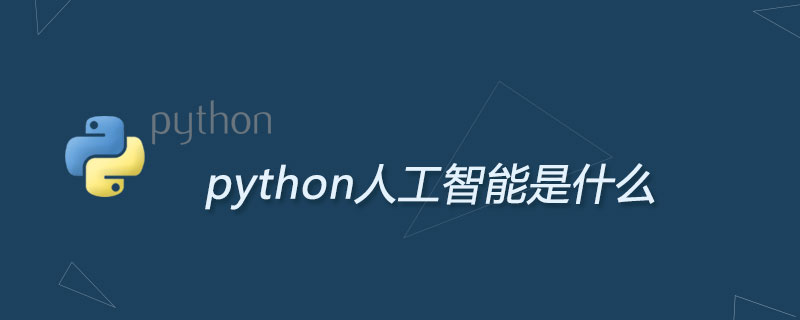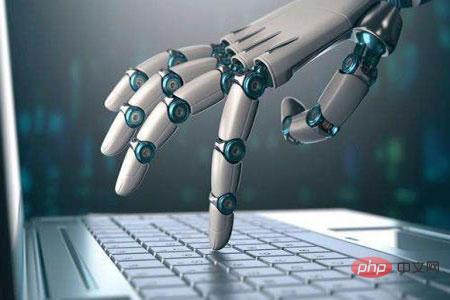What does python artificial intelligence mean?
Python artificial intelligence refers to the realization of artificial intelligence based on the Python platform. Python is a widely used scripting language, and artificial intelligence is a new technical science that studies and develops theories, methods, technologies and application systems for simulating, extending and expanding human intelligence.

#Python is a very widely used scripting language. Google's web pages are written in Python. Python has demonstrated powerful functions in many fields such as biological information, statistics, web page production, and computing.

Artificial Intelligence (Artificial Intelligence), the English abbreviation is AI. It is a new technical science that studies and develops theories, methods, technologies and application systems for simulating, extending and expanding human intelligence. Artificial intelligence can simulate the information process of human consciousness and thinking. Python can be applied in the field of artificial intelligence, but Python alone cannot replace artificial intelligence.
The relationship between artificial intelligence and Python
The origin of artificial intelligence and Python lies in. Just like when we collect statistics or choose to use Excel to create tables, because when we need to use addition, subtraction, multiplication, division or functions, etc., we only need to apply the company. Because behind the operation of functions such as SUM and AVERAGE, the code has been written in languages such as C/C#, so Excel is only a tool and presentation form and does not perform calculations. Similarly, when learning artificial intelligence, Python is only a tool used to operate the deep learning framework. The main module responsible for actual calculations does not rely on Python. What really works is a lot of complex C/CUDA programs.
When deep learning artificial intelligence, the calculations are too complicated and they have to write C code to operate. At this time, programmers want to directly build the neural network, fill in the parameters, and not create a complicated Excel configuration table. Import the data and start training the model and get the results directly with the click of a button. This method is simple and practical, but the neural network is too complicated to build, there are too many parameters that need to be filled in, and the various options make it difficult to make it an intuitive graphical tool. You can only use a relatively easy-to-use language like Python to build a neural network, fill in parameters, import data, and call execution functions for training through simplified program code. Use this language to describe the model, transfer parameters, convert the input data, and then throw it into a complex deep learning framework for calculation. So why choose Python?
Scientists have long been fond of using Python to experiment with algorithms, and are also good at using numpy for scientific calculations and pyplot for drawing data graphs. It happens that Python is used a lot internally at Google, so it is inevitable to use Python. In addition to Python, the TensorFlow framework actually also supports JavaScript, c, Java, GO, and other languages. Ordinarily, artificial intelligence algorithms can also use these. But the official said that languages other than Python do not necessarily promise API stability. So artificial intelligence and Python are inseparable.
Speaking of the core algorithm of artificial intelligence, it is completely dependent on C/C. Because it is computationally intensive, it requires very fine optimization and interfaces such as GPU and dedicated hardware. These are all Only C/C can do this. So in a sense, C/C is actually the most important language in the field of artificial intelligence. Python is the API binding of these libraries. To develop a cross-language interface from other languages to C/C, Python is the easiest. It is much lower than the ffi threshold of other languages. CPython's C API is bidirectionally integrated and can be directly Exposing encapsulated Python objects to the outside world also allows users to introduce new features by inheriting these custom objects, and even call Python functions from C code.
Python has always been an important tool for scientific computing and data analysis. Python is the API binding of these libraries. To develop a cross-language interface from other languages to C/C, Python is the easiest, compared to other languages. The threshold of ffi is much lower. CPython's C API is bidirectionally integrated. It can directly expose encapsulated Python objects to the outside world. It also allows users to introduce new features by inheriting these custom objects, and can even call them from C code. Python functions. It is said that times make heroes. It can also be said that artificial intelligence and Python achieve each other. Artificial intelligence algorithms promote the development of Python, and Python also makes algorithms simpler.
The above is the detailed content of What does python artificial intelligence mean?. For more information, please follow other related articles on the PHP Chinese website!

Hot AI Tools

Undresser.AI Undress
AI-powered app for creating realistic nude photos

AI Clothes Remover
Online AI tool for removing clothes from photos.

Undress AI Tool
Undress images for free

Clothoff.io
AI clothes remover

AI Hentai Generator
Generate AI Hentai for free.

Hot Article

Hot Tools

Notepad++7.3.1
Easy-to-use and free code editor

SublimeText3 Chinese version
Chinese version, very easy to use

Zend Studio 13.0.1
Powerful PHP integrated development environment

Dreamweaver CS6
Visual web development tools

SublimeText3 Mac version
God-level code editing software (SublimeText3)

Hot Topics
 1381
1381
 52
52
 PHP and Python: Code Examples and Comparison
Apr 15, 2025 am 12:07 AM
PHP and Python: Code Examples and Comparison
Apr 15, 2025 am 12:07 AM
PHP and Python have their own advantages and disadvantages, and the choice depends on project needs and personal preferences. 1.PHP is suitable for rapid development and maintenance of large-scale web applications. 2. Python dominates the field of data science and machine learning.
 How to train PyTorch model on CentOS
Apr 14, 2025 pm 03:03 PM
How to train PyTorch model on CentOS
Apr 14, 2025 pm 03:03 PM
Efficient training of PyTorch models on CentOS systems requires steps, and this article will provide detailed guides. 1. Environment preparation: Python and dependency installation: CentOS system usually preinstalls Python, but the version may be older. It is recommended to use yum or dnf to install Python 3 and upgrade pip: sudoyumupdatepython3 (or sudodnfupdatepython3), pip3install--upgradepip. CUDA and cuDNN (GPU acceleration): If you use NVIDIAGPU, you need to install CUDATool
 Detailed explanation of docker principle
Apr 14, 2025 pm 11:57 PM
Detailed explanation of docker principle
Apr 14, 2025 pm 11:57 PM
Docker uses Linux kernel features to provide an efficient and isolated application running environment. Its working principle is as follows: 1. The mirror is used as a read-only template, which contains everything you need to run the application; 2. The Union File System (UnionFS) stacks multiple file systems, only storing the differences, saving space and speeding up; 3. The daemon manages the mirrors and containers, and the client uses them for interaction; 4. Namespaces and cgroups implement container isolation and resource limitations; 5. Multiple network modes support container interconnection. Only by understanding these core concepts can you better utilize Docker.
 How is the GPU support for PyTorch on CentOS
Apr 14, 2025 pm 06:48 PM
How is the GPU support for PyTorch on CentOS
Apr 14, 2025 pm 06:48 PM
Enable PyTorch GPU acceleration on CentOS system requires the installation of CUDA, cuDNN and GPU versions of PyTorch. The following steps will guide you through the process: CUDA and cuDNN installation determine CUDA version compatibility: Use the nvidia-smi command to view the CUDA version supported by your NVIDIA graphics card. For example, your MX450 graphics card may support CUDA11.1 or higher. Download and install CUDAToolkit: Visit the official website of NVIDIACUDAToolkit and download and install the corresponding version according to the highest CUDA version supported by your graphics card. Install cuDNN library:
 Python vs. JavaScript: Community, Libraries, and Resources
Apr 15, 2025 am 12:16 AM
Python vs. JavaScript: Community, Libraries, and Resources
Apr 15, 2025 am 12:16 AM
Python and JavaScript have their own advantages and disadvantages in terms of community, libraries and resources. 1) The Python community is friendly and suitable for beginners, but the front-end development resources are not as rich as JavaScript. 2) Python is powerful in data science and machine learning libraries, while JavaScript is better in front-end development libraries and frameworks. 3) Both have rich learning resources, but Python is suitable for starting with official documents, while JavaScript is better with MDNWebDocs. The choice should be based on project needs and personal interests.
 How to choose the PyTorch version under CentOS
Apr 14, 2025 pm 02:51 PM
How to choose the PyTorch version under CentOS
Apr 14, 2025 pm 02:51 PM
When selecting a PyTorch version under CentOS, the following key factors need to be considered: 1. CUDA version compatibility GPU support: If you have NVIDIA GPU and want to utilize GPU acceleration, you need to choose PyTorch that supports the corresponding CUDA version. You can view the CUDA version supported by running the nvidia-smi command. CPU version: If you don't have a GPU or don't want to use a GPU, you can choose a CPU version of PyTorch. 2. Python version PyTorch
 MiniOpen Centos compatibility
Apr 14, 2025 pm 05:45 PM
MiniOpen Centos compatibility
Apr 14, 2025 pm 05:45 PM
MinIO Object Storage: High-performance deployment under CentOS system MinIO is a high-performance, distributed object storage system developed based on the Go language, compatible with AmazonS3. It supports a variety of client languages, including Java, Python, JavaScript, and Go. This article will briefly introduce the installation and compatibility of MinIO on CentOS systems. CentOS version compatibility MinIO has been verified on multiple CentOS versions, including but not limited to: CentOS7.9: Provides a complete installation guide covering cluster configuration, environment preparation, configuration file settings, disk partitioning, and MinI
 How to install nginx in centos
Apr 14, 2025 pm 08:06 PM
How to install nginx in centos
Apr 14, 2025 pm 08:06 PM
CentOS Installing Nginx requires following the following steps: Installing dependencies such as development tools, pcre-devel, and openssl-devel. Download the Nginx source code package, unzip it and compile and install it, and specify the installation path as /usr/local/nginx. Create Nginx users and user groups and set permissions. Modify the configuration file nginx.conf, and configure the listening port and domain name/IP address. Start the Nginx service. Common errors need to be paid attention to, such as dependency issues, port conflicts, and configuration file errors. Performance optimization needs to be adjusted according to the specific situation, such as turning on cache and adjusting the number of worker processes.




